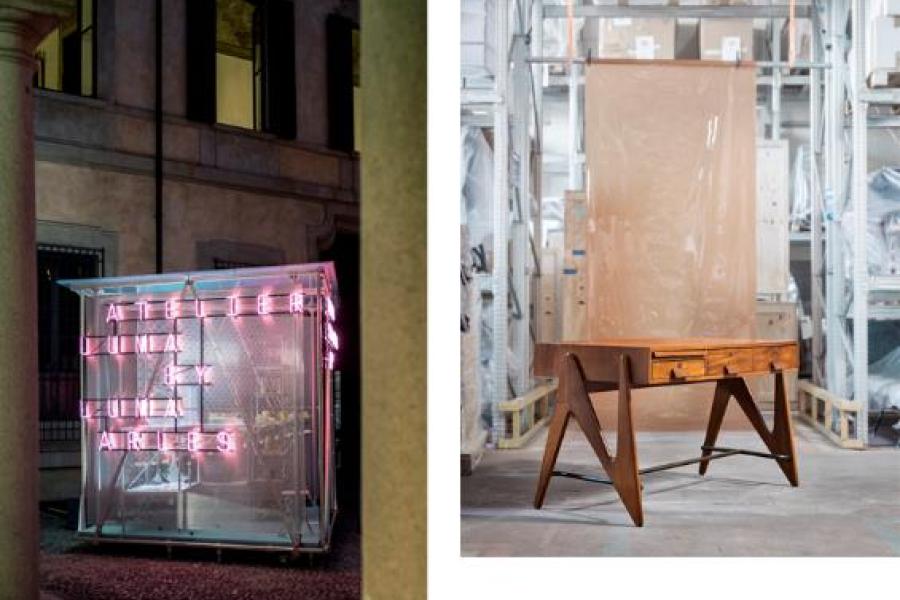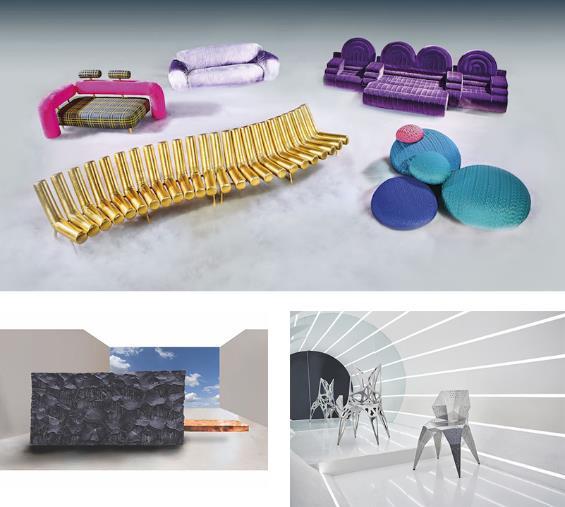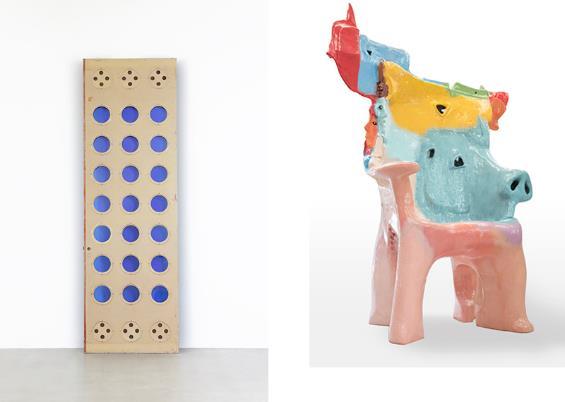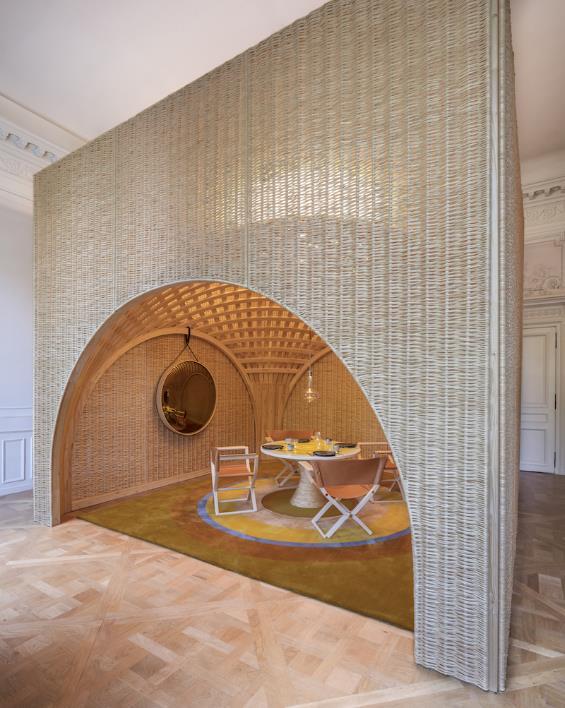Design Miami/ Basel 2018 curated by french photographer François Halard
 Shelves and cloakrooms for the Dujardin store in Knokke-le-Zoute/ By Gaetano Pesce (b. 1939)/ 1994/ © Marie Clérin / Galerie Downtown Paris - François Laffanour - Mit freundlicher Genehmigung von: designmiami
Shelves and cloakrooms for the Dujardin store in Knokke-le-Zoute/ By Gaetano Pesce (b. 1939)/ 1994/ © Marie Clérin / Galerie Downtown Paris - François Laffanour - Mit freundlicher Genehmigung von: designmiamiWer: Design Miami
Was: Presse
Wann: 16.05.2018
The 2018 program centers on the theme of twentieth and twenty-first century architectural expression and is organized by the celebrated photographer François Halard, known for his distinctive images of intimate spaces and their architecture. Halard has portrayed the houses, gardens, and ateliers of singular personalities around the world, including Louise Bourgeois, Luigi Ghirri, Saul Leiter, Robert Rauschenberg, and Cy Twombly, as well as such architectural masterpieces as Casa Malaparte, Capri; Villa Noailles, Hyères, France; and La Maison de Verre, Paris.
“François’s eye for detail and his encyclopedic knowledge of iconic works of art, design and architecture make him a natural collaborator for Design at Large,” says Rodman Primack, Chief Creative Officer, Design Miami/. “We could not dream up a better partner for this program.” Halard considers time to be one of his most frequent collaborators––his patience and knowledge are the key elements of his visionary work. He elaborates on this concept and his vision for Design at Large:
“Art and design have been influencing me since I was a child. My parents opened my eyes to this world and to how art, furniture, architecture, planning, the landscape and each one of its details impact the way we live. In my work as a photographer I often endeavor to capture the essence of art and design by documenting ideas that manifest in something physical, this includes the structures that define the way we live. I strive to focus on the elements that elevate our experience of living. Meaningful design is impactful and lasts, it adds so much value to the world and to our lives, it withstands the test of time, sometimes defining a moment, sometimes setting the stage for the next one.
Time is one of the essential components of my work. All of the elements that contribute to each one of the photographs are affected by it––in quite literal ways like light and exposure, where there is a second hand constantly ticking and impacting the image. I choose to work in film, which records this relationship and then again needs time to be developed and processed. I am also an absolute fan of the Polaroid, which has its own specific relationship with time and light, an instant alchemy of control and chance. I have spent a great deal of my life waiting: waiting for the clouds to pass, waiting for the proofs to arrive, waiting for the garden to be at its peak, and waiting for the letter or email confirming access to a special place. Again, time. It took fifteen years before I was able to capture the inimitable Cy Twombly in his Gaeta studio, and it was worth it.
With Design at Large and the various projects presented I am looking at how the past has influenced the now and how the now may influence the tomorrow, it is all linked. Ideas are the bedrock of art and design––will and craft makes them physical, and time is the mediator. In some of these projects we can see concepts that have defined the last fifty years of art and design as well as in other ways we may see the seeds of the cities of tomorrow, and yet only time will tell.” --François Halard
Design at Large ProjectsThe nine Design at Large projects are unified by Halard’s concept, which centers on the lasting impact of good design on our lives and on the world around us. Historical design continues to inform contemporary practices today, and today’s practitioners will go on to influence the future of design.
Masatoshi Izumi and Koichi Hara’s Stone Screen Tokonoma, presented by Gallery JaponesqueIn Masatoshi Izumi and Koichi Hara’s Stone Screen, nature challenges architecture, refocusing our attention through the tension and communication between the two. The central element, a heavy, gravitational mass, is also a mask—an obstruction through which we cannot see. Its surface, mottled with controlled, single strokes of breakage, evokes human respect for the strength of stone. Upon approaching, we must ask, “What could be on the other side?” A hint is offered with the tokonoma: a simple projection of wood that destabilizes the symmetry of the work. The plank enables inhabitation—as a table or a bench it draws us around and into the space between the Stone Screen and the perimeter of the space in which it resides. The other side reveals the tokonoma’s support to be another stone, this time a horizontally laid anchor, regrounding the project to the site. Also on view is Hara’s déjà vu ZaZen II, a shikkui meditation space.
Jean Prouvé’s Architecture, presented by Galerie Patrick Seguin This selection is a series of emblematic elements of architecture spanning Jean Prouvé’s oeuvre, comprising works from both Prouvé’s demountable houses and schools as well as examples of his iconic mur rideau (curtain wall) facades. Collectively they point to Prouvé’s avant-garde risk-taking as a constructor, and individually they reflect the diverse commissions and projects upon which Prouvé embarked particularly in France and Africa. The range of materials that compose the panels, including aluminum, metal, glass, and wood, reflects Prouvé’s mastery of them in his endless quest for simplicity and efficiency that rendered this aesthetic his own. Two of these panels feature the circular “hublot” windows, a markedly distinct motif synonymous with Prouvé. These elements illustrate Prouvé’s important contribution to French midcentury architecture that continues to have a resounding influence today. Arranged in a freestanding cube, the works can be appreciated from all sides, separately, and as an ensemble.
Gaetano Pesce’s Dujardin, presented by LAFFANOUR–Galerie Downtown In 1994 the talented Italian designer Gaetano Pesce was commissioned to create the architecture and the interior design for Dujardin children’s store in Knokke-Le-Zoute on the Belgian coastline. This opportunity allowed Pesce to combine utility with joyfulness, art with design, and aesthetics with functionality. The architect offers us the essence of his artistic research with a succession of colors, lines, shapes, and materials that are perfectly representative of his work, his sense of humor, his style, and innovative ideas. This playful, rich, and colorful architecture retains its usefulness, but is armed with a new function. It is no longer just about designing industrialized forms; for Pesce, design becomes the real support for an artistic, political, or social discourse.Always eager to shake up codes and common ideas, Pesce continues to surprise us almost twenty-five years after the creation of the Dujardin store.
Gaetano Pesce’s Sedia Portaritratti, presented by Salon 94 Design Sedia Portaritratti is a monumental installation conceived by Gaetano Pesce. The title of the work is a play on the Italian words for “drawing,” “portrait,” and “frame.” The four-meter-tall standing chair, covered in human caricature portraits, displays a variety in figuration—more than twenty distinct faces—that stands for the diversity and uniqueness of human nature. The enormous chair is an homage to both the collective and the individual. In an era in which everything adheres to a specific standard and there are so many global constants, uniqueness and individuality are what draws the future closer and what transforms the present into progress.
RDAI Architecture’s Dining Room Pavilion, presented by Galerie Philippe GravierDining Room Pavilion is a complex micro- architecture, a cupola within a wooden trelliswork. The dome houses a warm and surprisingly inviting dining room. Its materials are natural and unprocessed, and with little furniture and few objects within, the pavilion’s atmosphere is almost ascetic, despite its classical Latin volumes. The lighting is diffused and enveloping. RDAI practices architecture, interior architecture, and design. Under the creative direction of Denis Montel, the agency Rena Dumas founded in 1972 is imbued with her legacy of rigor and elegance. RDAI Architecture was established in 2007 to focus on architectural projects. The creativity and versatility of RDAI have won the agency an international reputation. The firm’s recent work demonstrates the dexterity that has enabled it to conceive a diverse range of projects within a single sphere of ideas. Working on all scales, from entire buildings to interior environments and individual objects, RDAI’s distinguishing characteristic is its conceptual approach, which involves considering the whole in order to produce a rational and coherent project.
Zhang Zhoujie Digital Lab’s Endless Form, presented by Gallery ALLThis pioneering project incorporates artificial intelligence into the design process. For more than eight years the Zhang Zhoujie Digital Lab has been exploring how AI can map the real world and how to create individualized furniture based on its interactions with humans. This led to the development of the hardware sensor chair, which collects data when people sit on it. Zhang then developed software to use those data points to generate chairs in various forms that uniquely fit an individual’s body. Each chair is thus the result of collaboration between people and computers. According to Zhang, “Human emotions, instincts, and needs are complementary to artificial intelligence.” At first glance, these chairs look like they came from another world, with their futuristic perspectives and surprising angles. Though each is unique, as if a freely grown object, all are constructed of the same material and structural logic to create a unified whole. Fifty individual chairs and the hardware sensor chair, which visitors can interact with, are included in the exhibition. Zhang graduated from Central Saint Martins School of Art and Design in London and is a member of the Architectural Association School of Architecture. Since establishing Zhang Zhoujie Digital Lab in 2010, he has been a pioneer in the realm of digital creativity. His work is known for being independent, experimental, and futuristic. Zhang believes that objects in the digital world can grow and morph much like things found in nature, and he is dedicated to discovering and exploring the methods within these transformations. His work focuses on logic, variety, and unpredictability, which is based on his understanding of nature. “It’s not about designing something,” he says. “It’s about finding something.”
DiscoGufram Presented by GuframGufram’s restless energy and joie de vivre could not find a better way to explode during Design Miami/ Basel. Based on the historical pieces the company has presented in its colorful catalogues since the tumultuous and fascinating times of the Italian Radical Design movement, Gufram asks visitors to dance at DiscoGufram, its very own visionary disco. Discover how a symbolic place like the discotheque, a space intertwined with pop culture since the mid-1960s, can be rethought and reshaped by contemporary objects to combine past and present. Gufram invited three groups of creative minds—Italian Atelier Biagetti (Alberto Biagetti and Laura Baldassari), Dutch ROTGANZEN (Robin Stam and Joeri Horstink,) and French GGSV (Gaëlle Gabillet and Stéphane Villard)—to create a surreal disco. In this project Gufram pushes the limits of furniture to offer an energetic, kaleidoscopic, and enthusiastic experience. At DiscoGufram, every floor can be a dance floor.
Lina Bo Bardi Giancarlo Palanti Studio d’Arte Palma 1948 – 1951 Presented by Nilufar GalleryFocusing on the work realized at the Estúdio de Arte e Arquitetura Palma, Nilufar Gallery presents the largest collection of Lina Bo Bardi’s furniture ever brought together. Many of the pieces displayed are rare objects originating in Brazil. The unique combination of the iconic and the everyday in her furniture is a powerful expression of the designer’s all- encompassing philosophy of design. As an architect, designer, scenographer, editor, writer, and illustrator, Bo Bardi was a woman of almost unlimited talent whose design vision was generous and uncompromising across a variety of disciplines. Studying architecture in Italy during World War II, Bo Bardi joined the resistance, an experience that profoundly shaped her understanding of architecture as a political and social endeavor. Later on, in Brazil, this sensibility matured and became the inspiration for sharp texts, open environments, and extraordinary buildings. Integrating architecture with furniture design, interiors, and often curating the programming of her public buildings, Bo Bardi created a bond between people and the spaces they inhabit. She pursued this ambition by mastering craft and fabrication processes in order to highlight the natural and local qualities of the materials and cultures around her. Collaborations with people from diverse fields were crucial to construct an extensive and shared body of knowledge. This is the case of Italian architect Giancarlo Palanti, with whom she founded the Estúdio de Arte e Arquitetura Palma, which designed and produced several furniture pieces.
Atelier Luma Presented By The Luma FoundationAtelier Luma presents four pavilions displaying a selection of Atelier Luma’s projects developed from natural resources— algae, sunflowers, mussel waste, and rice husks—to create sustainable, innovative materials such as biopolymer and biolamin ate. The modular pavilions are covered with biomaterials, illustrating the potential uses of natural resources and waste––part of Aterlier Luma’s social design initiative that promotes new means of production that rely on local knowledge, craftsmanship, and technology. The Luma Foundation launched Atelier Luma in 2016 as part of an experimental cultural center under construction in Arlies in the South of France. The think tank, production workshop, and learning network is creating a cross-disciplinary center that builds on the local resources and ecological context and a social network of individuals and talent in Arles and beyond.
“Design at Large has been one of the most anticipated and popular programs at Design Miami/ Basel, and this year’s edition lives up to its reputation,” says Jennifer Roberts, Chief Executive Officer, Design Miami/. “We are thrilled to have François working with the incredible talent represented in these diverse projects to thread together this ambitious program.”
 The Algae Lab pavilion/ Atelier Luma in collaboration with Cookies and III+1, 2018 /Courtesy of Luma Foundation Studio d’Arte Palma 1948 – 1951/ Lina Bo Bardi Giancarlo Palanti, 1949 – 1950 ca./ Courtesy of Nilufar Gallery - Mit freundlicher Genehmigung von: designmiami / Design Miami
The Algae Lab pavilion/ Atelier Luma in collaboration with Cookies and III+1, 2018 /Courtesy of Luma Foundation Studio d’Arte Palma 1948 – 1951/ Lina Bo Bardi Giancarlo Palanti, 1949 – 1950 ca./ Courtesy of Nilufar Gallery - Mit freundlicher Genehmigung von: designmiami / Design MiamiSchedule of Events/Show SchedulePreview Day/ By invitation only Monday, June 11, 2018 Collectors Preview/ 12–5pm Vernissage/ 5–7pmPublic Show DaysTuesday, June 12/ 10am–8pm Wednesday, June 13/ 10am–8pm Thursday, June 14/ 10am–7pm Friday, June 15/ 10am–7pm
Saturday, June 16/ 11am–7pm Sunday, June 17/ 11am–7pm
 DiscoGufram, sofas by Atelier Biagetti, 2018/ Courtesy of Gufram/ © TOILETPAPER Night & Day (Kamano, Starful Night and ToKoNoMA)/ Masatoshi Izumi and Koichi Hara, 1998– 2017/ Courtesy of Gallery Japonesque Endless Form/ Zhang Zhoujie Digital Lab/ Courtesy of Gallery ALL - Mit freundlicher Genehmigung von: designmiami / Design Miami
DiscoGufram, sofas by Atelier Biagetti, 2018/ Courtesy of Gufram/ © TOILETPAPER Night & Day (Kamano, Starful Night and ToKoNoMA)/ Masatoshi Izumi and Koichi Hara, 1998– 2017/ Courtesy of Gallery Japonesque Endless Form/ Zhang Zhoujie Digital Lab/ Courtesy of Gallery ALL - Mit freundlicher Genehmigung von: designmiami / Design Miami Jean Prouvé/ Courtesy of Galerie Patrick Seguin Sedia Portaritratti/ Gaetano Pesce, 2016/ Courtesy of the artist and Salon 94 Design - Mit freundlicher Genehmigung von: designmiami / Design Miami
Jean Prouvé/ Courtesy of Galerie Patrick Seguin Sedia Portaritratti/ Gaetano Pesce, 2016/ Courtesy of the artist and Salon 94 Design - Mit freundlicher Genehmigung von: designmiami / Design Miami Dining Room Pavilion/ RDAI Architects, 2016/ Galerie Philippe Gravier - Mit freundlicher Genehmigung von: designmiami / Design Miami
Dining Room Pavilion/ RDAI Architects, 2016/ Galerie Philippe Gravier - Mit freundlicher Genehmigung von: designmiami / Design MiamiCopyright © 2024 findART.cc - All rights reserved
